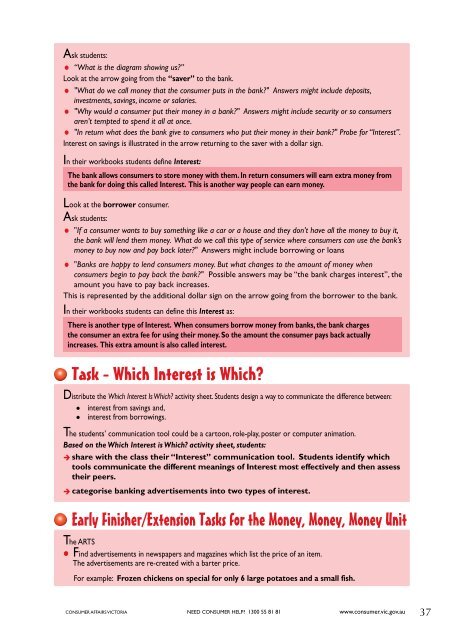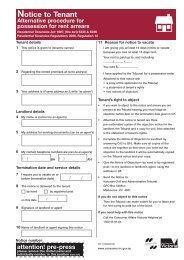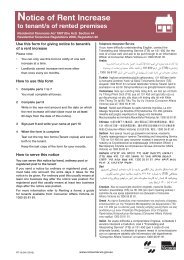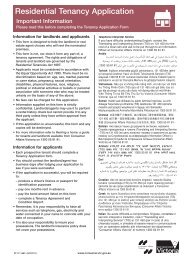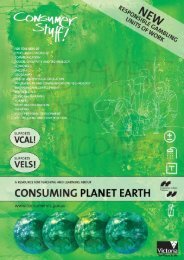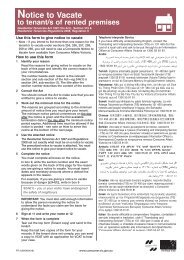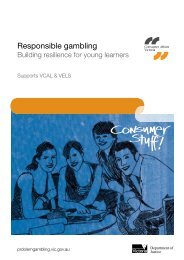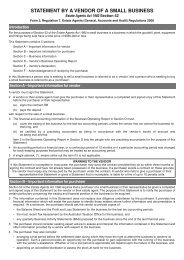Consumer Stuff for kids (PDF, 6.2 MB) - Consumer Affairs Victoria
Consumer Stuff for kids (PDF, 6.2 MB) - Consumer Affairs Victoria
Consumer Stuff for kids (PDF, 6.2 MB) - Consumer Affairs Victoria
Create successful ePaper yourself
Turn your PDF publications into a flip-book with our unique Google optimized e-Paper software.
Ask students:<br />
“What is the diagram showing us?”<br />
Look at the arrow going from the “saver” to the bank.<br />
"What do we call money that the consumer puts in the bank?" Answers might include deposits,<br />
investments, savings, income or salaries.<br />
"Why would a consumer put their money in a bank?" Answers might include security or so consumers<br />
aren’t tempted to spend it all at once.<br />
"In return what does the bank give to consumers who put their money in their bank?" Probe <strong>for</strong> “Interest”.<br />
Interest on savings is illustrated in the arrow returning to the saver with a dollar sign.<br />
In their workbooks students define Interest:<br />
The bank allows consumers to store money with them. In return consumers will earn extra money from<br />
the bank <strong>for</strong> doing this called Interest. This is another way people can earn money.<br />
Look at the borrower consumer.<br />
Ask students:<br />
"If a consumer wants to buy something like a car or a house and they don’t have all the money to buy it,<br />
the bank will lend them money. What do we call this type of service where consumers can use the bank’s<br />
money to buy now and pay back later?" Answers might include borrowing or loans<br />
"Banks are happy to lend consumers money. But what changes to the amount of money when<br />
consumers begin to pay back the bank?" Possible answers may be “the bank charges interest”, the<br />
amount you have to pay back increases.<br />
This is represented by the additional dollar sign on the arrow going from the borrower to the bank.<br />
In their workbooks students can define this Interest as:<br />
There is another type of Interest. When consumers borrow money from banks, the bank charges<br />
the consumer an extra fee <strong>for</strong> using their money. So the amount the consumer pays back actually<br />
increases. This extra amount is also called interest.<br />
Task - Which Interest is Which?<br />
Distribute the Which Interest Is Which? activity sheet. Students design a way to communicate the difference between:<br />
• interest from savings and,<br />
interest from borrowings.<br />
•<br />
The students’ communication tool could be a cartoon, role-play, poster or computer animation.<br />
Based on the Which Interest is Which? activity sheet, students:<br />
share with the class their “Interest” communication tool. Students identify which<br />
tools communicate the different meanings of Interest most effectively and then assess<br />
their peers.<br />
categorise banking advertisements into two types of interest.<br />
Early Finisher/Extension Tasks <strong>for</strong> the Money, Money, Money Unit<br />
The ARTS<br />
Find advertisements in newspapers and magazines which list the price of an item.<br />
The advertisements are re-created with a barter price.<br />
For example: Frozen chickens on special <strong>for</strong> only 6 large potatoes and a small fish.<br />
CONSUMER AFFAIRS VICTORIA NEED CONSUMER HELP? 1300 55 81 81 www.consumer.vic.gov.au<br />
37


